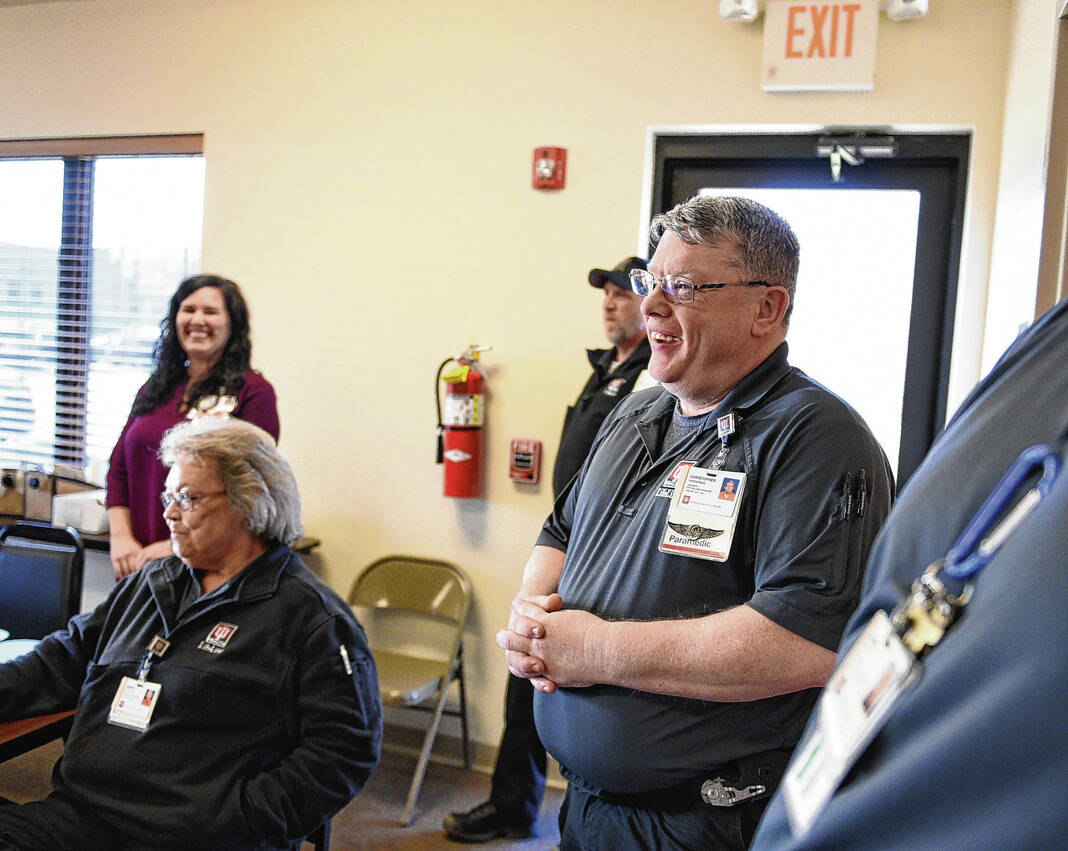
Indiana University Health Lifeline paramedic Chris Henderson smiles during a presentation of his Care Champion award from IU Health’s System Health Solutions on April 7. Henderson received the award for going “above and beyond” his role as a paramedic to help a local elderly couple who were struggling to maintain independent living. Henderson worked to connect them with community resources and make sure the couple’s family was aware of the situation.
Suzannah Couch | The Democrat
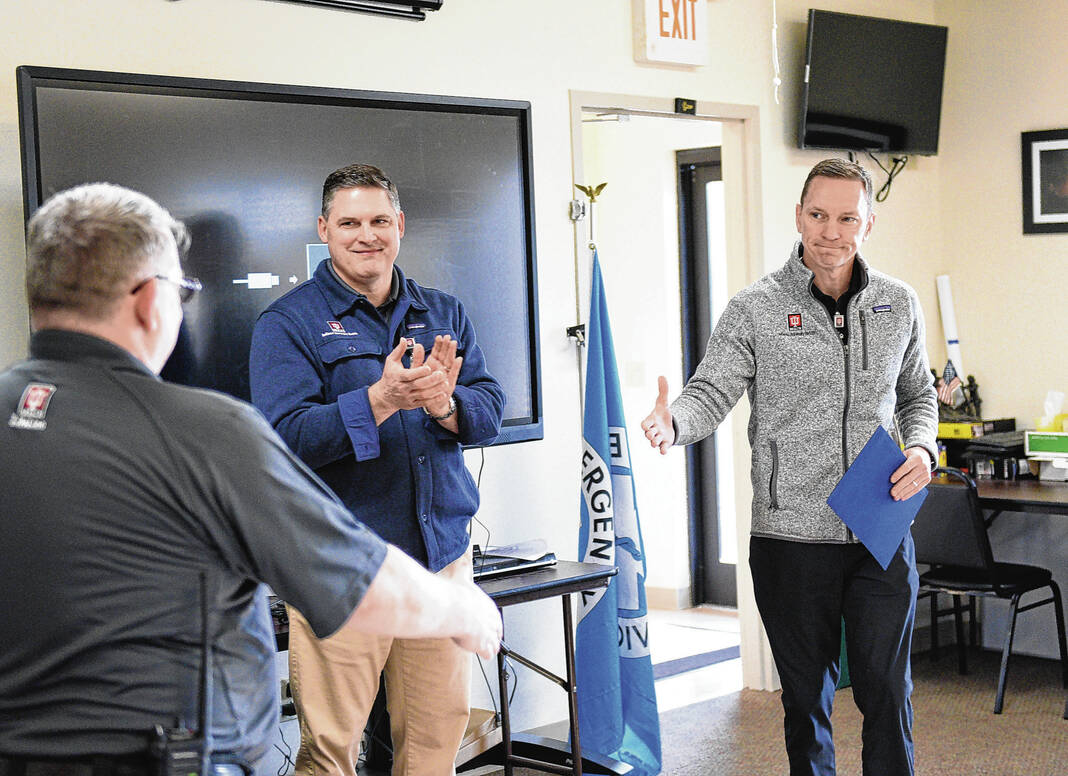
Indiana University Health Lifeline paramedic Chris Henderson goes to shake the hand of Ron Stiver, the president of IU Health’s System Health Solutions, during a presentation of Henderson’s Care Champion award on April 7. Henderson received the award for going “above and beyond” his role as a paramedic to help a local elderly couple who were struggling to maintain independent living. Henderson worked to connect them with community resources and make sure the couple’s family was aware of the situation.
Suzannah Couch | The Democrat
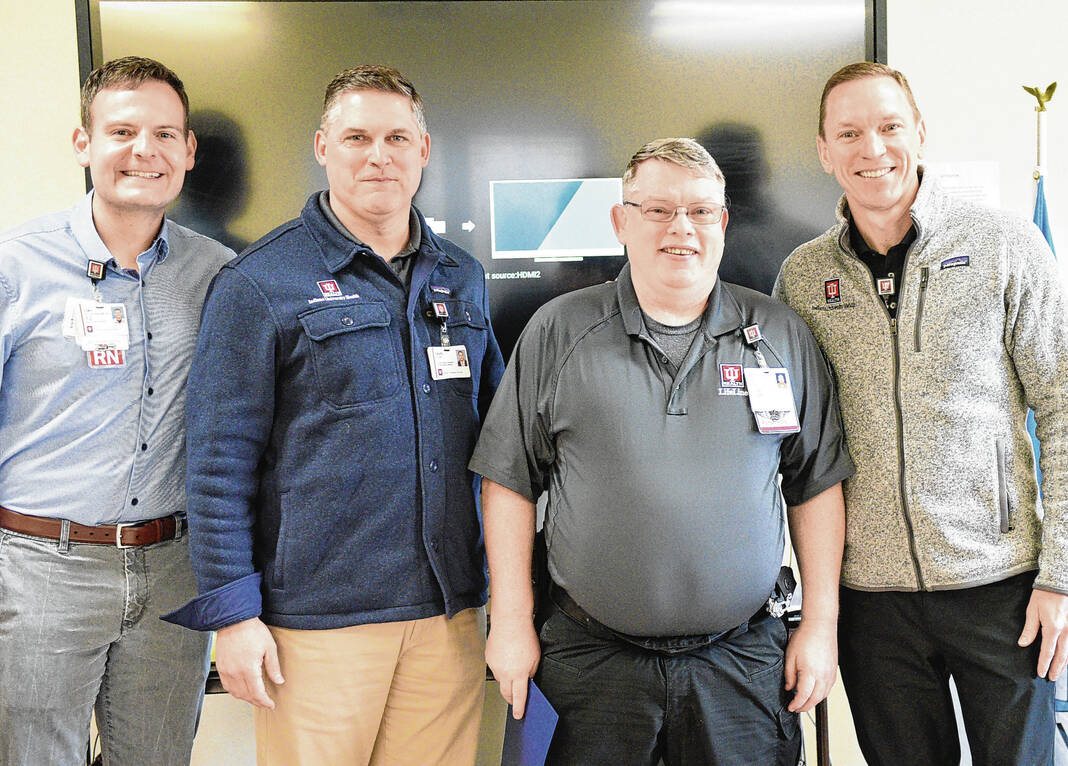
From left: Indiana University Health statewide director of emergency services Cory Hall, Senior Vice President of System Health Solutions David Kogan, IU Health Lifeline paramedic Chris Henderson and President of SHS Ron Stiver pose for a photo on April 7. Henderson was recognized that day as the SHS Care Champion for for going “above and beyond” his role as a paramedic to help a local elderly couple who were struggling to maintain independent living.
Suzannah Couch | The Democrat
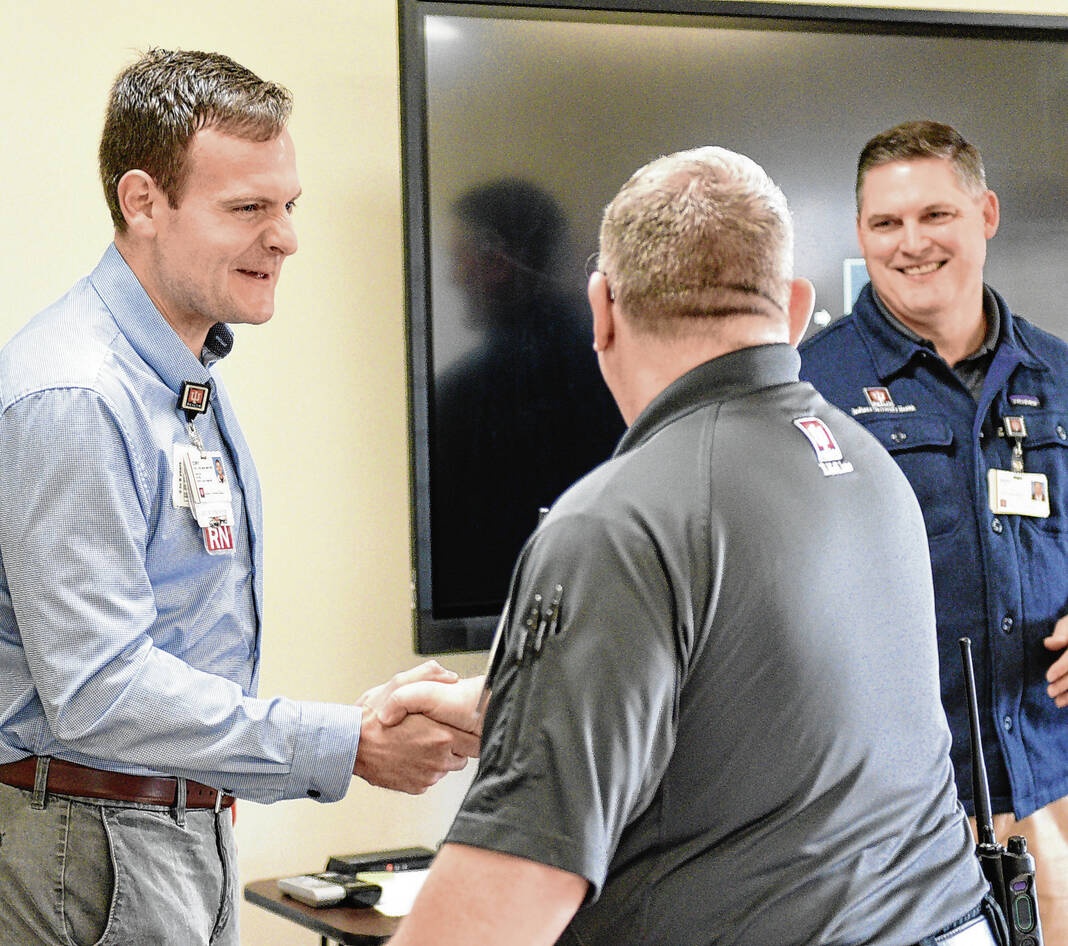
Indiana University Health Lifeline paramedic Chris Henderson shakes the hand of Cory Hall, IU Health statewide director of emergency services, during a presentation of Henderson’s Care Champion award on April 7. Henderson received the award for going “above and beyond” his role as a paramedic to help a local elderly couple who were struggling to maintain independent living. Henderson worked to connect them with community resources and make sure the couple’s family was aware of the situation.
Suzannah Couch | The Democrat

Indiana University Health Lifeline paramedic Chris Henderson speaks to the group gathered for his Care Champion award ceremony on April 7. Henderson received the Care Champion award from IU Health’s System Health Solutions for going “above and beyond” his role as a paramedic to help a local elderly couple who were struggling to maintain independent living. Henderson worked to connect them with community resources and make sure the couple’s family was aware of the situation.
Suzannah Couch | The Democrat
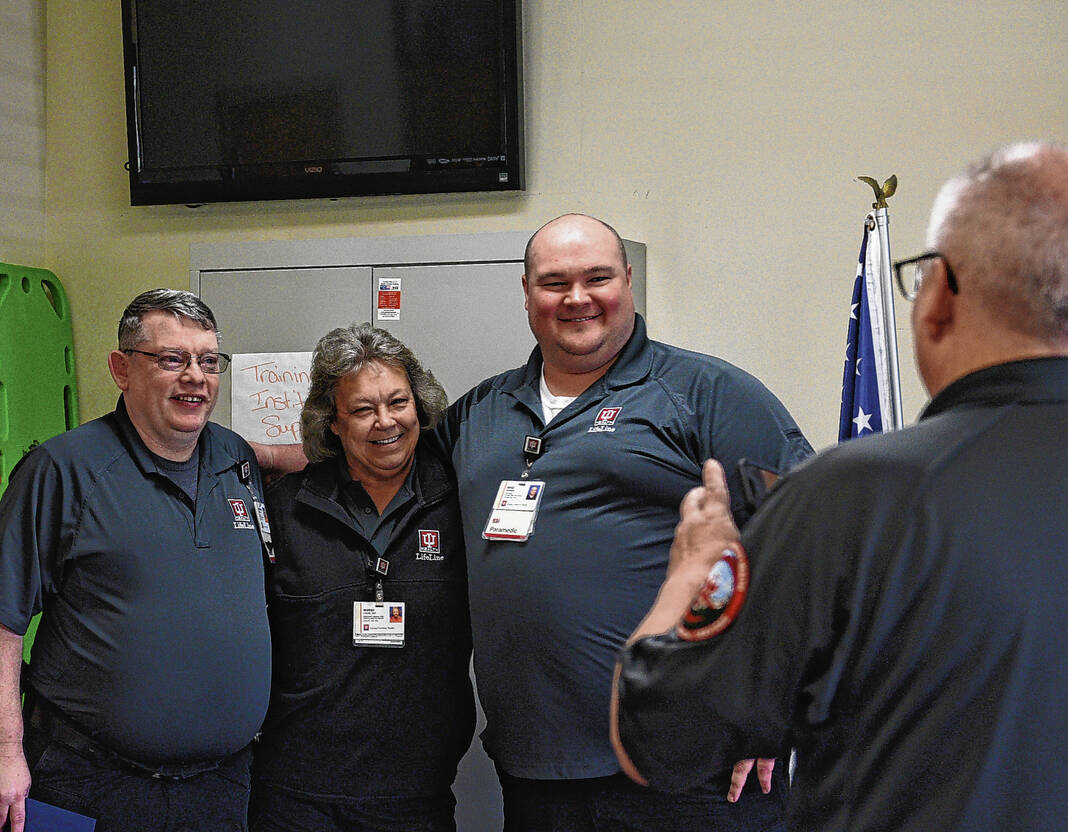
Indiana University Health Lifeline paramedic Chris Henderson poses for a photo with EMT Margo Ayers and paramedic/educator Brad Warren on April 7. Henderson received the Care Champion award from IU Health’s System Health Solutions for going “above and beyond” his role as a paramedic to help a local elderly couple who were struggling to maintain independent living. Henderson worked to connect them with community resources and make sure the couple’s family was aware of the situation.
Suzannah Couch | The Democrat

Indiana University Health Lifeline paramedic Chris Henderson smiles as he holds his Care Champion award certificate on April 7. Henderson received the award from IU Health’s System Health Solutions for going “above and beyond” his role as a paramedic to help a local elderly couple who were struggling to maintain independent living. Henderson worked to connect them with community resources and make sure the couple’s family was aware of the situation.
Suzannah Couch | The Democrat

Indiana University Health Lifeline paramedic Chris Henderson speaks to the group gathered for his Care Champion award ceremony on April 7. Henderson received the Care Champion award from IU Health’s System Health Solutions for going “above and beyond” his role as a paramedic to help a local elderly couple who were struggling to maintain independent living. Henderson worked to connect them with community resources and make sure the couple’s family was aware of the situation.
Suzannah Couch | The Democrat
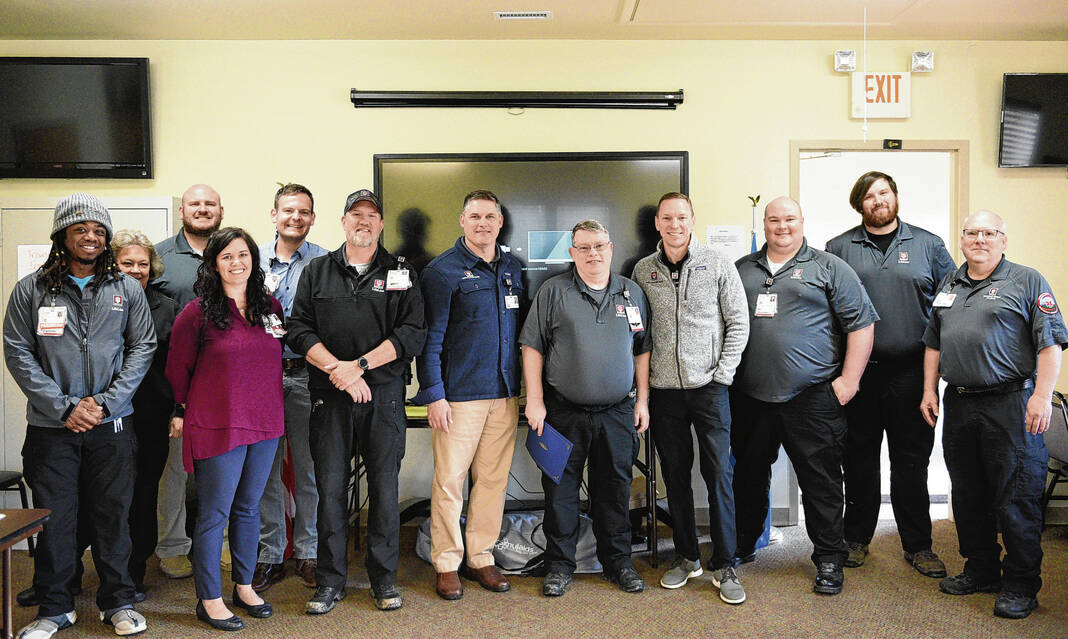
Indiana University Health Lifeline Paramedic Chris Henderson was formally presented with his IU Health System Health Solutions Care Champion award on April 7. From left: paramedic Robvis Stamp, EMT Margo Ayers, paramedic/educator Chris Harper, regional Lifeline supervisor Kate Pedigo, IU Health statewide director of emergency services Cory Hall, paramedic Dave Frensemeier, SHS Senior Vice President David Kogan, Henderson, SHS President Ron Stiver, paramedic/educator Brad Warren, EMT Kevin Line and paramedic/educator Ken Farr.
Suzannah Couch | The Democrat

Regional Indiana University Health Lifeline Supervisor Kate Pedigo speaks to paramedic Chris Henderson on April 7 during a presentation of Henderson’s Care Champion award from IU Health System Health Solutions. “I remember in your interview just seeing the passion and I was like ‘Whoa,’” Pedigo said of Henderson. “We are lucky to have you.”
Suzannah Couch | The Democrat
The importance of taking care of others was instilled in Christopher Henderson at a young age.
For most of Henderson’s life, his father was ill and he would take care of him. When he was in the hospital Henderson was home, caring for his mother and two sisters.
This caused Henderson to do a lot of growing up as a teenager. At 16, he began working at nursing homes.
In 1988, he started studying geography at Indiana University. Around that time he enrolled in an EMT class, receiving his certification in July 1990. He was first hired as an EMT in February of 1991, spending most of his time working Saturdays at the Brown County Dragway and riding along at night with the ambulance here gaining more experience in the field.
He met his wife and in 1992 they moved to Columbus. He received his advanced EMT certification in 1993. After taking some time off from college, Henderson received his geography degree in 1995 and began working for a company in Indianapolis converting utility company paper maps to a digital Geographic Information System (GIS) system.
He continued to work as an EMT in Brown County on the weekends.
When that Indianapolis office was closed, Henderson began working full time as an advanced EMT in the county in 2002.
And that is where he stayed.
Fast forward over decades of service to April 7 as Henderson stands at the back of a meeting room in the county’s Emergency Medical Services building with a smile on his face.
He thought he was walking into another standard meeting with Indiana University’s Health regional Lifeline supervisor Kate Pedigo. But there were more surprise guests in the meeting room and a certificate in a blue folder awaiting him.
Henderson was given the IU Health’s System Health Solutions Care Champion award earlier this year. The surprise gathering was a way to formally recognize Henderson for going “above and beyond” his role as paramedic for residents here.
“This is for someone who exhibits tremendous passion, values, being innovative, problem solving – all the things that go into delivering care for patients, exceptional care for patients — being a great teammate, all of that included,” said David Kogan, SHS Senior Vice President.
“We’re excited to be here today to be able to distribute one of these very important awards. It is very prestigious. I think it in this case, of course, it is very well deserved.”
Story continues below gallery.
Henderson received the Care Champion award for helping connect a local elderly couple to community resources after responding to several calls involving them and realizing they were struggling to maintain independent living.
He then spent time with the couple and their neighbors to better understand their living situation before connecting them with community resources. He also made sure the couple’s family was aware of the situation, according to a press release from IU Health.
Contacting a local food pantry and other community resources in the county, Henderson worked to ensure the couple would have regular visits to their home to check on them. He also made sure the couple’s family was aware of their situation. They now live closer to family.
The Care Champion award is given out quarterly to recognize “the hard work, innovative ideas and significant contributions” taking place across System Health Solutions.
SHS President Ron Stiver likened receiving the award to being named a sports all-star for the year.
“He went above and beyond to secure those resources, to make sure the family was well taken care of,” he said on April 7.
“Brother, we need more of you. … This is a great award and great recognition, but I can’t tell you how thankful we are to have you on the team. You are exactly who IU Health is at its best.”
And his co-workers agree.
Paramedic Dave Frensemeier credits Henderson as being one of his main supporters when he decided to leave his job at Cummins Inc. to work EMS full time.
“Chris has been a great asset to this community over the years. His commitment to taking care of people is unmatched,” Frensemeier said.
“He is still a great help to me these days as a friend and supporter on my tough days where calls just don’t go the way I hoped. I think his passion and commitment to get community paramedicine off the ground is incredible. I believe Brown County is a perfect place for it to start.”
Henderson said he began hearing about the idea of community paramedicine in 2017. A community paramedicine program would have its own ambulance and responders on it who would go to homes and identify any problems or needs for a resident who may have had an ambulance called to their home multiple times or kept returning to the hospital with the same issues.
The program would not replace other at home care, like occupational or physical therapy.
“It is to identify problems and to get the proper resources that a family member or the patient needs in order to be healthier at home, to avoid going to the hospital,” Henderson said.
Following the presentation of his award on April 7, Henderson took a moment to speak about the idea of community paramedicine and bringing that to Brown County.
“Hopefully that can take off here in the next two or three years. That is where my passion is really at,” he said.
Stiver said the hope is IU Health can bring that to Brown County.
“The example you showed us is exactly proof of that model and what kind of impact it can have,” he said.
Rural challenges
So, what has kept Henderson working on an ambulance in a rural area like Brown County for decades? The answer is simple: more time with his patients.
In 2005, Henderson was certified as a paramedic. A paramedic is able to give a patient medicines, do basic procedures, like tracheotomies, and more invasive procedures like putting in a chest tube to inflate a partly collapsed lung.
Working in a rural area and spending sometimes as long as 45 minutes in an ambulance with a patient, Henderson gets to see how patients react to his treatments — which is the part he loves the most.
“You get to Columbus or Bloomington they are only three to eight minutes away from the hospital where depending where I am at it could be 40 to 45 minutes, so I get to see how treatments actually work. That is what I enjoy. Plus I have more interactions with the family members and so forth,” he said.
“In the urban setting the hospital will be giving a lot of those meds where in the rural community we will be giving them those medications,” he added.
Rural EMS also differs from EMS in cities because residents in an area like Brown County often rely on ambulances or going to the EMS base for regular check outs due to the low number of doctors here and limited hours in the evenings or weekends.
“A lot of times it is just to verify they are OK. Just have their blood pressure checked or something like that. Or if they have a small wound we help them bandage it,” Henderson said.
But lacking resources is also a challenge in rural communities.
With only two ambulances based in the county, not having additional help when responding to calls, like multiple vehicle accidents, can also be a challenge.
And sometimes having a long ambulance ride can be a challenge when paramedics and EMTs reach the end of their protocols then have to call a doctor to help them treat the patient while on the way to the hospital. Henderson said IU Health Lifeline is always looking for new technology and equipment to help when there are not enough hands on board to assist with a transport or call.
Despite the challenges, this is what Henderson loves to do. Serving his community, even outside of the ambulance, comes naturally. He organizes the community Thanksgiving dinner each year. This year will mark the 40th anniversary of the dinner, which is now run by the Brown County YMCA after the EMT Association dissolved in 2019 after hosting it for several years.
Henderson stayed on to help organize the dinner with the YMCA to make sure it still happens for residents, including seniors who live alone and may not have a family to celebrate with on Thanksgiving. He also helped to convert the dinner to a drive-thru following the COVID-19 pandemic. Each year his family stands with him serving up hot meals to residents.
“My family doesn’t know anything other than the community Thanksgiving dinner,” Henderson said in 2019.
Identifying gaps
When Henderson first started working in Brown County he was trained by former Brown County EMT Mark Wayt who unofficially trained Henderson in community paramedicine. The EMS building in Nashville is named after Wayt who served as an EMT here for 20 years.
“He was big on knowing the resources of the community. What was out there and looking at what are the resources we created,” Henderson said.
“That is all most of us are doing, trying to identify what could be the best to keep the patient at home with their family members,” he continued about those in community paramedicine.
A community paramedic could potentially spend hours at a home for an initial visit educating a patient on their illness and how best to treat it or helping them find transportation to their primary care doctor to get necessary medications preventing another hospital visit.
“It (community paramedic program) is to identify problems, identify safety risks at the home, check to see if they are taking medications properly,” Henderson said.
Or it could be teaching a patient about a disease, like diabetes, and letting them know how often should test their blood sugar.
“It may be we find out that this person cannot get in and out of the house because they don’t have a ramp, so we may be able to identify that and find someone to install a ramp that is ADA (Americans with Disabilities Act) compliant. If EMS is responding to a patient constantly falling we need to figure out why they are constantly falling,” Henderson said.
Referrals for community paramedicine could come from a hospital or EMS. For example, if an ambulance continues to making runs to help a person who has fallen in their home then a community paramedic could respond to help identify fall risks in the home.
“It is to identify gaps in our healthcare system,” Henderson said.
But many steps have to be taken before community paramedicine can be launched locally, including completing a community health needs assessment that would take a “picture of the health of the county,” Henderson said.
“What resources do we have like doctors and clinics? That includes all the way from pediatricians to lactation nurses to mental health to substance abuse, the nursing home, group homes, the school system. Bring those people to the table, we figure out a plan then this community health needs assessment is done and evaluated,” he said.
Finding funding for a community paramedicine program can also be a barrier. In some areas insurance companies fund a community paramedicine program and sometimes hospitals will fund a similar program by re-routing the savings from not seeing repeat patients. Other programs are funded by grants, Henderson said.
Last year, Brown County was formally recognized by the Rural Health Organization as a rural county. Previously the county was considered urban due to its proximity to Indianapolis. Being reclassified by RHO as a rural county will hopefully open up more grant and healthcare opportunities, Henderson said.
“This is not going to be instantaneous, but it is something we are working on or trying to pursue,” Henderson said of community paramedicine.
“There are so many different ways we can develop this (to fit the needs of the county). Until we know what we have and what we need, I can’t say how this picture is going to look.”

